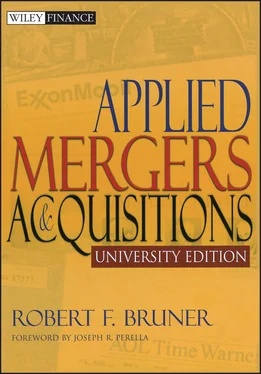†Significant at the 99 percent confidence level.
EXHIBIT 5.8 Returns to Buyers of Foreign Targets
| Study |
Cumulative Abnormal Returns (% or avg$/acq) |
Sample Size |
Sample Period |
Event Window (Days) |
Notes |
| Conn, Connell (1990) |
–0.0787 *a non-U.S.(DMM) –0.0677 *a non-U.S.(IMM) –0.025 U.S. (DMM) –0.026 U.S. (IMM) |
73 |
1971–1980 |
–1,0 |
“Non-U.S.” and “U.S.” indicate country of buyer firm. “IMM” indicates returns estimated using a market model with an international market index. “DMM” uses a domestic market index. |
| Kang (1993) |
0.0059 Japanese buyers |
119 |
1975–1988 |
–1,0 |
Focus is non-U.S. buyers of U.S. targets. |
|
–0.029. U.S. buyers Difference is significant at 5%. |
102 |
|
|
|
| Mathur et al. (1994) |
–0.0026 |
77 |
1984–1988 |
–1,+1 |
Focus is non-U.S. buyers of U.S. targets. |
| Servaes, Zenner (1994) |
0.0044 takeovers 0.0005 units and minority interests |
70 |
1979–1988 |
–1,0 |
Focus is non-U.S. buyers of U.S. targets. |
| Eun, Kolodny, Scheraga (1996) |
–0.0120 all observations 0.0318 Canadian buyers 0.0362 Japanese buyers –0.0428 U.K. buyers –0.0046 all other buyers |
117 |
1979–1990 |
–5,0 |
Focus is non-U.S. buyers of U.S. targets. |
| Cakici et al. (1996) |
0.0046 *foreign bidder 0.0000 U.S. bidder |
195 |
1983–1992 |
–1,0 |
Focus is non-U.S. buyers of U.S. targets. |
| Doukas, Travlos (1988) |
0.009 All observations –0.0003 operating in target’s country 0.011 not operating in target’s country 0.0199 *going abroad first time |
301 |
1975–1983 |
–1,0 |
Focus is U.S. buyers of foreign targets. |
| Pettway, Sicherman, Speiss, (1993) |
0.0152 † |
16 |
1981–1991 |
–1,0 |
Focus is Japanese buyers of U.S. targets. |
| Markides, Ittner (1994) |
0.0032 all observations 0.0055 related acquisitions –0.0087 unrelated |
274 |
1975–1988 |
–1,0 |
Focus is U.S. buyers of foreign targets. |
| Yook, McCabe (1996) |
0.0046 all observations 0.0085 large acquisitions |
98 |
1979–1989 |
–1,0 |
Focus is U.S. buyers of foreign targets. |
| Biswas et al. (1997) |
0.00126 all observations 0.00277 U.S. buyer, foreign target 0.00015 foreign buyers, foreign targets –0.00399 *U.S. buyer and target |
125 |
1977–1987 |
–1,0 |
Focus is buyers of foreign targets. |
| Kiymaz, Mukherjee (2000) |
Strong effects of monthly stock returns and relative GNP growth rates of two countries. |
112 |
1982–1991 |
–1,0 |
Focus is U.S. buyers of foreign targets. |
| Eckbo, Thorburn (2000) |
–0.0030 U.S. buyers 0.0171 Canadian buyers |
390 1,261 |
1964–1983 |
–1,0 |
Focus is U.S. and Canadian buyers of Canadian firms. |
| Kuipers, Miller, Patel (2003) |
–0.92% –$31.26MM |
138 |
1982–1991 |
–1,0 |
Focus is foreign acquirers of U.S. targets. |
*Significant at the 95 percent confidence level.
†Significant at the 99 percent confidence level.
EXHIBIT 5.9 Summary of Shareholder Return Studies for M&A: Combined Returns to Shareholders of Acquiring Firm and Target Firm
| Study |
Cumulative Abnormal Returns |
Sample Size |
Sample Period |
Event Window (Days) |
Notes |
| Eun, Kolodny, Scheraga (1996) |
$68 million, average combined wealth changes. $398 million. |
117 |
1979–1990 |
–5,0 |
Focus is non-U.S. buyers and U.S. targets. |
| Biswas et al. (1997) |
$135.4 million, average combined wealth changes, international acquisitions; 3.39% as percentage of size. $2.04 million, domestic acquisitions; 2.02% as percentage of size. Both are significant at 5%. |
125 |
1977–1987 |
–5,+5 |
Focus is buyers of foreign targets. |
| Kuipers, Miller, Patel (2003) |
+2.99% *$121.86 MM † |
120 |
1982–1991 |
–1,0 |
Focus is U.S. targets and foreign acquirers. |
*Significant at 95 percent confidence level.
†Significant at 99 percent confidence level.
STRATEGIC ANALYSIS OF COUNTRIES: GETTING A VIEW
The extensive research on foreign direct investment and on investor reaction to announcements of cross-border acquisitions underscores how important it is for the practitioner to have a view about a country in which an acquisition is contemplated. Such a view would inform the analysis of deals with insights about:
Expected economic growth in the country and region. Exhibit 5.10depicts the development curve of a country over time, commonly used by economists to convey the evolutionary process by which a country achieves developed status. The country progresses from entrepôt (distribution center), through stages of rising value-added manufacturing, to highly integrated operations. In seeking to gauge the attractiveness of a country market, the M&A analyst can use a framework such as the path of development to assess the current status and future outlook for a country.
Foundations of special competitive advantage stemming from unique resources or capabilities. Porter (1990) highlighted the role of clusters of competition within countries that creates capabilities.
Outlook for inflation, interest rates, and exchange rates.
Relative valuation of assets. EXHIBIT 5.10 The Curve of Country Development
Risks. Expectations about any of these elements are never certain. Country analysis should identify the sources of uncertainty and the size of their influence. A quick assessment of the risk in a country might be derived from its sovereign debt risk rating.
Most government issues are rated for default risk by major rating agencies. These form important assumptions that will underpin the cross-border deal evaluation outlined in Chapter 13. Four perspectives inform one’s view: macroeconomic, microeconomic, institutional, and cultural.
In the long run, national economic results are materially influenced by government policies in six areas:
1 Fiscal policy. This addresses the volume and priorities of government spending, as well as the means of financing that spending through taxes or the issuance of debt. Fiscal policy affects monetary, exchange rate, and employment policies. The key points of focus for an analyst are government surpluses or deficits, spending priorities, tax rates, and government indebtedness.
2 Monetary policy. Management of the national money supply through central bank and government activities is a major influence on inflation rates, interest rates, and currency exchange rates. Monetary policy affects fiscal policy, exchange rate policy, employment, and trade. Key points of focus for the analyst are interest rate levels and trends, inflation rates, the velocity of money, and government interventions that seek to influence these (e.g., open market transactions, bank reserve requirements, and discount window transactions).
3 Exchange rate policy. Governments may choose among a variety of alternatives from letting the national currency float against other currencies to fixing the rate of exchange (in terms of a commodity such as gold or other currencies). Exchange rates are closely linked to flows of capital and the national balance of payments. Exchange rate policy affects monetary, fiscal, trade, and employment policies. Key points of focus for the analyst are the trend and level of exchange rates, trade balances and capital flows (which indicate the relative supply and demand for the local currency), interventions in currency markets by the government or by supranational organizations such as the International Monetary Fund (IMF).
Читать дальше












